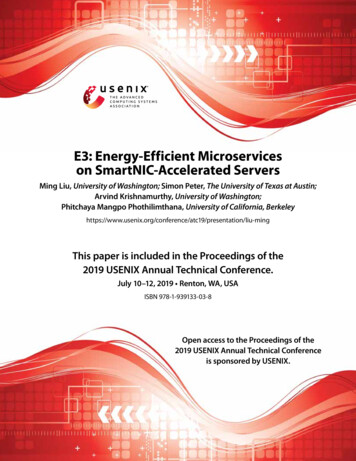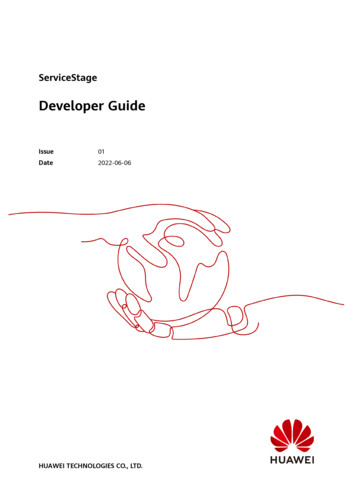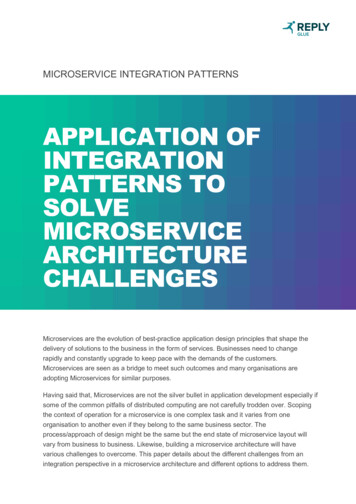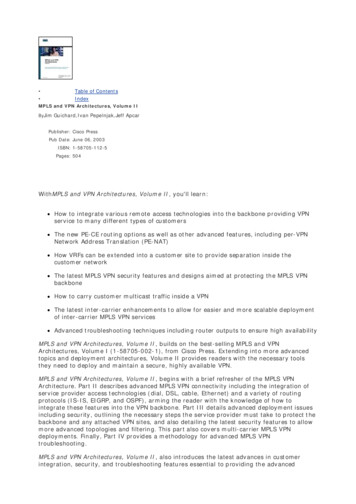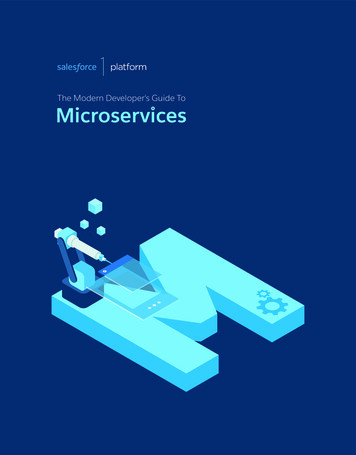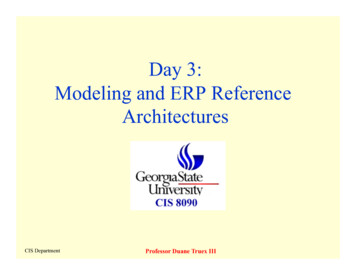
Transcription
Microservice ArchitecturesDr. Andreas Schroeder1
About me250 staff12 offfices (9 in Germany)Experts for developing custom IT solutionsInvolvement in the IT community via twitterDr. Andreas Schroeder githubcodecentric AG meetupElsenheimerstr 55A 80687 ntric.deblog.codecentric.de2
Agenda The Pain Therefore, Microservices Stable Interfaces: HTTP, JSON, REST Characteristics Comparison with Precursors Challenges With special focus on Service Versioning Conclusion3
The Pain
Observed problems Area of consideration Web systems Built collaboratively by several development teams With traffic load that requires horizontal scaling(i.e. load balancing across multiple copies of the system) Observation Such systems are often built as monoliths or layered systems (JEE)5
Software MonolithA Software Monolith One build and deployment unit One code base One technology stack (Linux, JVM, Tomcat, Libraries)Benefits Simple mental model for developers one unit of access for coding, building, and deploying Simple scaling model for operations just run multiple copies behind a load balancer6
Problems of Software Monoliths Huge and intimidating code base for developers Development tools get overburdened refactorings take minutes builds take hours testing in continuous integration takes days Scaling is limited Running a copy of the whole system is resource-intense It doesn’t scale with the data volume out-of-the-box Deployment frequency is limited Re-deploying means halting the whole system Re-deployments will fail and increase the perceived risk of deployment7
Layered SystemsA layered system decomposes a monolith into layers Usually: presentation, logic, data access At most one technology stack per layer Presentation: Linux, JVM, Tomcat, Libs, EJB client, JavaScript Logic: Linux, JVM, EJB container, Libs Data Access: Linux, JVM, EJB JPA, EJB container, LibsBenefitsPresentationLogicData Access Simple mental model, simple dependencies Simple deployment and scaling modelDB8
Problems of Layered Systems Still huge codebases (one per layer) with the same impact on development, building, and deployment Scaling works better, but still limited Staff growth is limited: roughly speaking, one team per layer works well Developers become specialists on their layer Communication between teams is biased by layer experience (or lack thereof)9
Growing systems beyond the limits Applications and teams need to grow beyond the limits imposed by monoliths and layered systems, and theydo – in an uncontrolled way. Large companies end up with landscapes of layered systems that often interoperate in undocumented ways. These landscapes then often break in unexpected ways.How can a company grow and still have a working IT architecture and vision? Observing and documenting successful companies (e.g. Amazon, Netflix) lead to the definition ofmicroservice architecture principles.10
Therefore, Microservices
History 2011: First discussions using this term ata software architecture workshop near Venice May 2012: microservices settled as the mostappropriate termJames Lewis March 2012: “Java, the Unix Way” at 33rd degreeby James Lewis September 2012: “µService Architecture“ atBaruco by Fred GeorgeFred George All along, Adrian Cockroft pioneered this styleat Netflix as “fine grained es.html#footnote-etymologyAdrian Cockroft12
Underlying principleOn the logical level, microservice architectures are defined by afunctional system decomposition into manageableand independently deployable components The term “micro” refers to the sizing: a microservice must be manageable by a single development team (5-9developers) Functional system decomposition means vertical slicing(in contrast to horizontal slicing through layers) Independent deployability implies no shared state and inter-process communication (often via HTTP REST-ishinterfaces)13
More specifically Each microservice is functionally complete with Resource representation Data management Each microservice handles one resource (or verb), e.g. Clients Shop Items Carts CheckoutMicroservices are fun-sized services, as in“still fun to develop and deploy”14
Independent Deployability is keyIt enables separation and independent evolution of code base technology stacks scaling and features, too15
Independent code baseEach service has its own software repository Codebase is maintainable for developers – it fits into their brain Tools work fast – building, testing, refactoring code takes seconds Service startup only takes seconds No accidental cross-dependencies between code bases16
Independent technology stacksEach service is implemented on its own technology stacks The technology stack can be selected to fit the task best Teams can also experiment with new technologies within a single microservice No system-wide standardized technology stack also means No struggle to get your technology introduced to the canon No piggy-pack dependencies to unnecessary technologies or libraries It‘s only your own dependency hell you need to struggle with Selected technology stacks are often very lightweight A microservice is often just a single process that is started via command line, and not code andconfiguration that is deployed to a container.17
Independent ScalingEach microservice can be scaled independently Identified bottlenecks can be addressed directly Data sharding can be applied to microservices as neededNetflixfunctional decomp. Parts of the system that do not represent bottlenecks canremain simple and un-scaledScalingCubeJEE Pet Storehorizontal & vertical18
Independent evolution of FeaturesMicroservices can be extended without affecting other services For example, you can deploy a new version of (a part of) the UI without re-deploying the whole system You can also go so far as to replace the service by a complete rewriteBut you have to ensure that the service interface remains stable19
Stable Interfaces – standardized communicationCommunication between microservices is often standardized using HTTP(S) – battle-tested and broadly available transport protocol REST – uniform interfaces on data as resources with known manipulation means JSON – simple data representation formatREST and JSON are convenient because they simplify interface evolution(more on this later)20
Stable Interfaces: HTTP, JSON, REST
HTTP ExampleGET / HTTP/1.1Host: www.codecentric.deConnection: keep-aliveCache-Control: max-age 0Accept: text/html,application/xhtml xml,application/xml;q 0.9,image/webp,*/*;q 0.8User-Agent: Mozilla/5.0 (Windows NT 6.1; WOW64) AppleWebKit/537.36 (KHTML, like Gecko)Chrome/38.0.2125.104 Safari/537.36Accept-Encoding: gzip,deflateAccept-Language: de-DE,de;q 0.8,en-US;q 0.6,en;q 0.4Cookie: HTTP/1.1 200 OKDate: Tue, 21 Oct 2014 06:34:29 GMTServer: Apache/2.2.29 (Amazon)Cache-Control: no-cache, must-revalidate, max-age 0Content-Encoding: gzipContent-Length: 8083Connection: closeContent-Type: text/html; charset UTF-822
HTTP Available verbs GET, POST, PUT, DELETE (and more) Safe verbs: GET (and others, but none of the above) Non-idempotent: POST (no other verb has this issue) Mechanisms for caching and cache control content negotiation session management user agent and server identification Status codes in response (200, 404, etc) forinformation, success, redirection, client error, server error Rich standardized interface for interacting over the net23
JSON Minimal and popular data representation format Schemaless in principle, but can be validated if need beExample of two bank accounts:[{"number" : 12345,"balance" : -20.00,"currency" : "EUR"},{"number" : 12346,"balance" : 120.00,"currency" : "USD"}]json.org24
REST REST is an architectural style for systems built on the web. It consists of a set of coordinated architecturalconstraints for distributed hypermedia systems. REST describes how to build systems on battle-tested protocols and standards that are already out there (likeHTTP) REST describes the architectural ideas behind HTTP, and how HTTP can be used to do more than serving staticweb content25
REST Architectural Constraints Client-Server: Separation of logic from user interface Stateless: no client context on the server Cacheable: reduce redundant interaction between client and server Layered System: intermediaries may relay communication between client and server (e.g. for load balancing) Code on demand: serve code to be executed on the client (e.g. JavaScript) Uniform interface Use of known HTTP verbs for manipulating resources Resource manipulation through representations which separated from internal representations Hypermedia as the engine of application state (HATEOAS):the response contains all allowed operations and the resource identifiers needed to trigger them26
HATEOAS example in JSONResource representation{ "number" : 12345,"balance" : -20.00,"currency" : "EUR",relation name (known by clients)"links" : [ {"rel" : "self","href" : "https://bank.com/account/12345"}, {"rel" : "deposit","href" : "https://bank.com/account/12345/deposit"} ]}URI for operation27
Stable Interfaces HTTP offers a rich set of standardized interaction mechanismsthat still allow for scaling JSON offers a simple data format that can be (partially) validated REST provides principles and ideas for leveraging HTTP and JSON to build evolvable microservice interfacesBe of the web, not behind the webIan Robinson28
Characteristics
Componentization via Services Interaction mode: share-nothing, cross-process communication Independently deployable (with all the benefits) Explicit, REST-based public interface Sized and designed for replaceability Upgrading technologies should not happen big-bang, all-or-nothing-style Downsides Communication is more expensive than in-process Interfaces need to be coarser-grained Re-allocation of responsibilities between services is harder30
Favors Cross-Functional Teams Line of separation is along functional boundaries, not along tiersPresentationLogicVSData AccessDB31
Decentralized GovernancePrinciple: focus on standardizing the relevant parts, andleverage battle-tested standards and infrastructureTreats differently What needs to be standardized Communication protocol (HTTP) Message format (JSON) What should be standardized Communication patterns (REST) What doesn‘t need to be standardized Application technology stack32
Decentralized Data Management OO Encapsulation applies to services as well Each service can choose the persistence solution thatfits best its Data access patterns Scaling and data sharding requirements Only few services really needenterprisey persistence33
Infrastructure Automation Having to deploy significant number of servicesforces operations to automate the infrastructure for Deployment (Continuous Delivery) Monitoring (Automated failure detection) Managing (Automated failure recovery) Consider that: Amazon AWS is primarily an internal service Netflix uses Chaos Monkey to further enforceinfrastructure resilience34
Comparisons with Precursors
DATASERVICEORCHESTRATIONService-Oriented Architecture36
Service-Oriented ArchitectureSOA systems also focus on functional decomposition, but services are not required to be self-contained with data and UI, most of the time the contrary is pictured. It is often thought as decomposition within tiers, and introducing another tier – the service orchestration tierIn comparison to microservices SOA is focused on enabling business-level programming through business processing engines and languagessuch as BPEL and BPMN SOA does not focus on independent deployment units and its consequences Microservices can be seen as “SOA – the good parts”37
Component-Based Software EngineeringUnderlying functional decomposition principle of microservices is basically the same.Additionally, the following similarities and differences exist: State model Many theoretical component models follow the share-nothing model Communication model Component technologies often focus on simulating in-process communication across processes (e.g. JavaRPC, OSGi, EJB) Microservice communication is intra-process, serialization-based Code separation model Component technologies do require code separation Components are often developed in a common code repository Deployment model Components are often thought as being deployed into a uniform container38
Challenges
Fallacies of Distributed ComputingEssentially everyone, when they first build a distributed application, makes the following eightassumptions. All prove to be false in the long run and all cause big trouble and painful learningexperiences. The network is reliable Latency is zero Bandwidth is infinite The network is secure Topology doesn‘t change There is one administrator Transport cost is zero The network is homogeneousPeter Deutsch40
Microservices PrerequisitesBefore applying microservices, you should have in place Rapid provisioning Dev teams should be able to automatically provision new infrastructure Basic monitoring Essential to detect problems in the complex system landscape Rapid application deployment Service deployments must be controlled and traceable Rollbacks of deployments must be cePrerequisites.html41
Evolving interfaces correctly Microservice architectures enable independent evolution of services – but how is this done without breakingexisting clients? There are two answers Version service APIs on incompatible API changes Using JSON and REST limits versioning needs of service APIs Versioning is key Service interfaces are like programmer APIs – you need to know which version you program against As service provider, you need to keep old versions of your interface operational while delivering newversions But first, let’s recap compatibility42
API CompatibilityThere are two types of compatibility Forward Compatibility Upgrading the service in the future will not break existing clients Requires some agreements on future design features, and the design of new versions to respect oldinterfaces Backward Compatibility Newly created service is compatible with old clients Requires the design of new versions to respect old interfacesThe hard type of compatibility is forward compatibility!43
Forward compatibility through REST and JSONREST and JSON have a set of inherent agreements that benefit forward compatibility JSON: only validate for what you really need, and ignore unknown object fields (i.e. newly introduced ones) REST: HATEOAS links introduce server-controlled indirection between operations and their URIs{ "number" : inks" : [ {"rel" : "deposit","href" : "https://bank.com/account/12345/deposit"} ]}44
Compatibility and VersioningCompatibility can’t be always guaranteed, therefore versioning schemes (major.minor.point) are introduced Major version change: breaking API change Minor version change: compatible API changeNote that versioning a service imposes work on the service provider Services need to exist in their old versions as long as they are used by clients The service provider has to deal with the mapping from old API to new API as long as old clients exist45
REST API VersioningThree options exist for versioning a REST service API1. Version URIshttp://bank.com/v2/accounts2. Custom HTTP headerapi-version: 23. Accept HTTP headerAccept: application/vnd.accounts.v2 jsonWhich option to choose? While developing use option 1, it is easy to pass around For production use option 3, it is the cleanest one46
REST API Versioning It is important to version your API directly from the start install a clear policy on handling unversioned calls Service version 1? Service most version? tful-services/47
Further Challenges Testing the whole system A single microservice isn‘t the whole system. A clear picture of upstream and downstream services is needed for integration testing Transactions Instead of distributed transactions, compensations are used (as in SOA) Authentication Is often offloaded to reverse proxies making use auf authentication (micro)services Request logging Pass along request tokens Add them to the log Perform log aggregation48
Conclusion
Microservices: just ? Just adopt? No. Microservices are a possible design alternative for new web systems and an evolution path for existingweb systems. There are considerable amounts of warnings about challenges, complexities and prerequisites ofmicroservices architectures from the community. Just the new fad? Yes and no. Microservices is a new term, and an evolution of long-known architectural principles applied ina specific way to a specific type of systems. The term is dev and ops-heavy, not so much managerial. The tech landscape is open source and vendor-free at the moment.50
Summary There is an alternative to software monoliths Microservices:functional decomposition of systems intomanageable and independently deployable services Microservice architectures means Independence in code, technology, scaling, evolution Using battle-tested infrastructure (HTTP, JSON, REST) Microservice architectures are challenging Compatibility and versioning while changing service interfaces transactions, testing, deploying, monitoring, tracing is/are harderMicroservices are no silver bullet, but may be the best way forward for large web systems built by professional software engineers51
Sources and Further Reading l http://www.infoq.com/articles/microservices-intro http://brandur.org/microservices ervices-what-are-micro-services.html http://12factor.net/ http://microservices.io/ vices ces-and-paas-part-iii ml ces-reality-check/52
Pictures Slide 1: Cover PictureBoris Macek Slide 6: MonolithMartin Dosch53
a software architecture workshop near Venice May 2012: microservices settled as the most appropriate term March 2012: “Java, the Unix Way” at 33rd degree by James Lewis September 2012: “µService Architecture“ at Baruco by Fred George All along, Adrian Cockr

